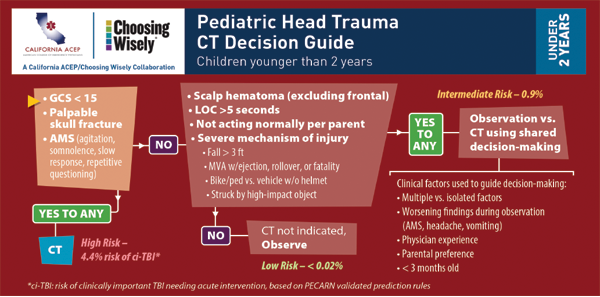
There was a single false-negative patient (missed fracture) who had a fracture adjacent to the hematoma. The authors describe the patient with the missed fracture as only requiring observation and no specific treatment.
Explore This Issue
ACEP Now: Vol 34 – No 09 – September 2015There were two false positives in the study. One false positive was by a novice scanner but was over-read as negative by a more senior clinician. This suggests training may be important to ensure accuracy. The second false positive was reported positive by both physicians reading the scan, which was not noted on CT. However, CT is not a 100 percent sensitive test either, and the patient may have had a true positive on ultrasound and false negative on CT.
Bottom Line: Emergency physicians can be taught POCUS to identify pediatric skull fractures with high specificity. When used along with a clinical decision instrument like PECARN, POCUS can be a useful adjunct for detecting skull fractures and further risk-stratifying minor head injuries. However, serious intracranial injuries can occur without fracture, and the sensitivity of ultrasound for fracture is not yet sufficient to use it as the sole method for detecting injury and making treatment and disposition decisions.
Case Resolution: Instead of ordering a CT, you decide to use POCUS to look for a skull fracture and combine this with the PECARN rule.
Mom is able to hold her daughter on her lap while you gently scan over and around the frontal hematoma. You are not able to identify a fracture. The parents are reassured and happy to avoid doing a CT scan at this time. The child is observed for a few hours in the ED as per the PECARN rule. They are discharged home with clear instructions to return if the clinical picture changes.
Thanks to Greg Hall, MD, who is faculty member at McMaster University in Hamilton, Ontario, and part of the Best Evidence in Emergency Medicine group, for his help with this review.
Remember to be skeptical of anything you learn, even if you learned it on the Skeptics’ Guide to Emergency Medicine.
Dr. Milne is chief of emergency medicine and chief of staff at South Huron Hospital, Ontario, Canada. He is on the Best Evidence in Emergency Medicine faculty and is creator of the knowledge translation project the Skeptics’ Guide to Emergency Medicine (www.TheSGEM.com).
References
- Weinberg ER, Tunik MG, Tsung JW. Accuracy of clinician-performed point-of-care ultrasound for the diagnosis of fractures in children and young adults. Injury. 2010;41:862-868.
- Jin W, Yang DM, Kim HC, et al. Diagnostic values of sonography for assessment of sternal fractures compared with conventional radiography and bone scans. J ultrasound Med. 2006; 5:1263-1268.
- You JS, Chung YE, Kim D, et al. Role of sonography in the emergency room to diagnose sternal fractures. J Clin Ultrasound. 2010;38:135-137.
- Riera A, Chen L. Ultrasound evaluation of skull fractures in children: a feasibility study. Pediatr Emerg Care. 2012;28:420-425.
- Parri N, Crosby BJ, Glass C, et al. Ability of emergency ultrasonography to detect pediatric skull fractures: a prospective, observational study. J Emerg Med. 2013;44:135-141.
Pages: 1 2 3 | Single Page






2 Responses to “When to Use Point-of-Care Ultrasound for Skull Fractures”
October 8, 2015
Kenn GhaffarianSensitivity in the article is misquoted at 8%. Should read 88%.
October 8, 2015
Dawn Antoline-WangThank you, we have corrected the error.